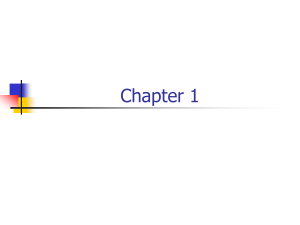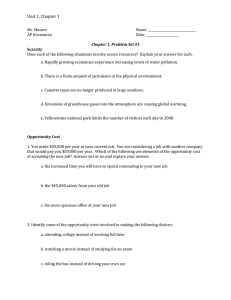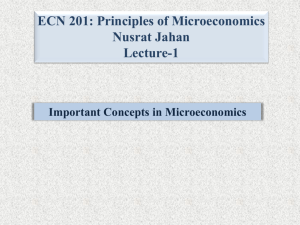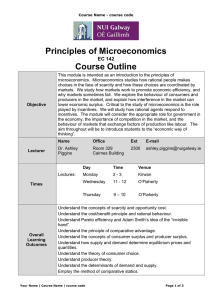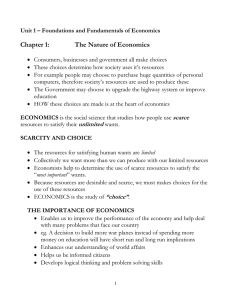Intermediate Microeconomics Class Notes
advertisement
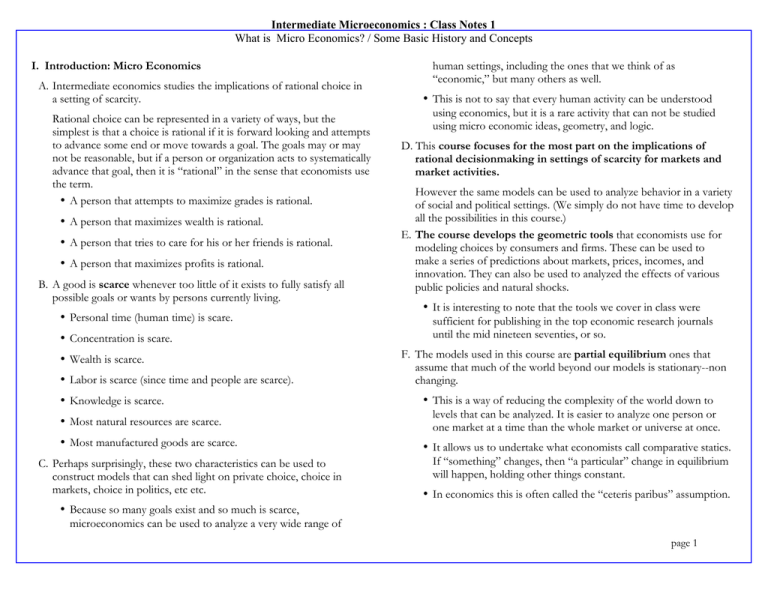
Intermediate Microeconomics : Class Notes 1 What is Micro Economics? / Some Basic History and Concepts I. Introduction: Micro Economics A. Intermediate economics studies the implications of rational choice in a setting of scarcity. Rational choice can be represented in a variety of ways, but the simplest is that a choice is rational if it is forward looking and attempts to advance some end or move towards a goal. The goals may or may not be reasonable, but if a person or organization acts to systematically advance that goal, then it is “rational” in the sense that economists use the term. w A person that attempts to maximize grades is rational. w A person that maximizes wealth is rational. w A person that tries to care for his or her friends is rational. w A person that maximizes profits is rational. B. A good is scarce whenever too little of it exists to fully satisfy all possible goals or wants by persons currently living. w Personal time (human time) is scare. w Concentration is scare. w Wealth is scarce. w Labor is scarce (since time and people are scarce). w Knowledge is scarce. w Most natural resources are scarce. w Most manufactured goods are scarce. C. Perhaps surprisingly, these two characteristics can be used to construct models that can shed light on private choice, choice in markets, choice in politics, etc etc. human settings, including the ones that we think of as “economic,” but many others as well. w This is not to say that every human activity can be understood using economics, but it is a rare activity that can not be studied using micro economic ideas, geometry, and logic. D. This course focuses for the most part on the implications of rational decisionmaking in settings of scarcity for markets and market activities. However the same models can be used to analyze behavior in a variety of social and political settings. (We simply do not have time to develop all the possibilities in this course.) E. The course develops the geometric tools that economists use for modeling choices by consumers and firms. These can be used to make a series of predictions about markets, prices, incomes, and innovation. They can also be used to analyzed the effects of various public policies and natural shocks. w It is interesting to note that the tools we cover in class were sufficient for publishing in the top economic research journals until the mid nineteen seventies, or so. F. The models used in this course are partial equilibrium ones that assume that much of the world beyond our models is stationary--non changing. w This is a way of reducing the complexity of the world down to levels that can be analyzed. It is easier to analyze one person or one market at a time than the whole market or universe at once. w It allows us to undertake what economists call comparative statics. If “something” changes, then “a particular” change in equilibrium will happen, holding other things constant. w In economics this is often called the “ceteris paribus” assumption. w Because so many goals exist and so much is scarce, microeconomics can be used to analyze a very wide range of page 1 Intermediate Microeconomics : Class Notes 1 What is Micro Economics? / Some Basic History and Concepts w Among the things that are often held constant are (i) the laws that define the “rules of the game,” (ii) the distribution of wealth, (iii) technology. w Farm hands and maidens did not often use money to buy things. Instead, they mainly traded their labor for food and shelter (or other farm output). [Trade without money is called barter.] w Of course every thing is not held constant, only the variables that we are not studying. w There was always some “commerce” in towns and at local market fairs, but only a fairly small fraction of the population lived in towns and depended entirely on commerce for their living. w Most sciences use this method. It underpins both experimental methodology and most research based on deduction G. For the most part, we’ll focus on the implications of rational choice and scarcity for market activities and outcomes: prices, production, profits, income, innovation, etc. w The main dish of intermediate micro is “pure theory.” w However, we’ll be developing lots of applications for that theory to show how it can be used and why it is used. II. A Little Bit of Economic History A. Microeconomics emerged as a field of study in the nineteenth century as a relatively small group of people (many, but not all, of them college professors) began to analyze the new, broader scope of commerce in ordinary life. B. Prior to 1700, essentially everyone was a farmer: some owned land, some worked on that land for the owners. w Many of these old farms were largely self sufficient. They made their own tools (mostly from wood), wove much of their own clothing, and grew most of their own food. w There was always some market activity in towns and between towns, but most farmers, farm hands and maids journeyed to town infrequently. Commerce took place, but for most people it was a “side dish” rather than the “main course” of their lives. C. One of the reasons measured GNP rapidly increased in the 18th and 19th centuries was the substitution of market production for household production. Only market production (sales) count for GNP. D. During the 18th, 19th, and 20th centuries, more and more of ordinary life became commercial, because people and organizations became more specialized, and money wages and purchasing goods and services became increasingly common and important. w Persons on farms, for example, began to purchase more and more of their cloth and clothing from people and organizations in towns that specialized in making cloth and or clothing. w Steel and Iron goods became cheaper for many reasons (including technological advance and changes in laws), which also led to more trading of goods and services. Miners, blacksmiths, engineers, etc., could not also grow their own food. w More and more people “hired themselves out for wages,” rather than working for room and board, and use the money paid to buy ALL of THEIR NECESSITIES of LIFE. E. Technological advancement and changes in laws (mostly deregulation and public education: changes that made entry into new businesses and occupations easier) led to more and more specialization and so more and more commerce (trade using money). page 2 Intermediate Microeconomics : Class Notes 1 What is Micro Economics? / Some Basic History and Concepts w By the end of the nineteenth century (in 1900) there were far fewer farmers, far more wage workers, and far more specialization both on and off the farm w Not all “modern” market systems worked as well as those in the West, because differences in laws and political systems matter nearly as much as the mode of production. w This continued through the 20th century in the US and what we now call “the West.”. H. This course attempts to provide the tools to think systematically about a wide variety of choice settings and market types. w Today, rather than 90-95% of us being farmers, only about 2% are. Its main goal is to provide the tools that you’ll need in other upper level courses such as public economics, law and economics, urban economics, environmental economics etc. The first half of the course develops models for thinking about rational choice and markets: (1) net benefit (consumer surplus and profit) maximization in one dimension and (2) competitive and monopolistic markets. The next part of the course develops somewhat more advanced models that allow intermediate market forms to be analyzed and choices in multiple dimensions to be analyzed. The second part begins with elementary game theory, which is another complementary method to model choice settings using rational choice models, then analyzes optimization in two dimensions (utility, output, and profit maximization), and ends with some topics beyond the core of neoclassical economics. I. The aim of the course is not to persuade you to favor specific policies, but to provide a variety of models that will help you to think more systematically and carefully about modern market-based relationships and societies. F. Commercial organizations (firms) grew larger and more numerous (because of specialization). w Many were larger than any previous private organizations, because they needed to be large to take full advantage of economies of scale. w Many of the new production methods were very capital and knowledge intensive. w Many production methods and products were completely new: steam engines, tractors, light bulbs, automobiles, airplanes, computers etc ... G. This highly specialized in interdependent form of life was new, and became the norm in the West by the early 1900s. w Most of the rest of the world also gradually adopted this system in the twentieth century, because of the material benefits of increased specialization and economies of scale. w More or less world wide market networks developed for a wide variety of products--far more products than in earlier times. w And so, a broad range of people, billions of them, became linked together through market trading networks of many kinds. w As a consequence, market actitivities--economics--is central to most peoples life in most parts of the world. III. Positive and Normative Economics A. For a lot of purposes in economics, it is useful to distinguish between positive issues--issues concerning how the world works--and normative issues--issues concerning whether the world works in a good or bad way. w Especially in areas dealing with public policy, it is often important to distinguish between the scientific problems of explanation and page 3 Intermediate Microeconomics : Class Notes 1 What is Micro Economics? / Some Basic History and Concepts prediction and the ethical problems of evaluation and recommendation. w Prediction and evaluation are two separate activities. And it is possible for people to agree about the future (predictions) yet still disagree about the ideal policy (evaluation). w The scope for disagreement is generally larger for the NORMATIVE analysis than for POSITIVE analysis. B. Many philosophers of science emphasis the distinction between normative and positive statements. (see for example Karl Popper) DEFINITIONS: A Positive Statement is a statement about what is, has been or will be. It is a statement about the world. A Normative Statement attempts to evaluate the desirability of alternative states of the world. C. Examples of Normative Theories w Cost Benefit Analysis / the Compensation Principle w Contractarianism: agreement (or agreement from behind a veil of ignorance) w The Pareto Criteria w Utilitarian Social Welfare Criteria w Green Idealism w Libertarian Idealism w Any other theory or ideology that allows one to determine "the best or worst" policy D. A positive theory is concerned with whether a claim is "true" or "false" rather than whether an alternative is "good" or "bad." w Of course, not every positive statement is true. w Science often makes progress by falsifying the “positive claims” of earlier theories. w In other cases, positive statements may be made that are false (lying about facts) in order to persuade others to buy particular products (fraud) or to induce voters to favor particular candidates or policies (rabble rousing). E. Generally, normative statements conclude that a particular policy is good or bad, is Pareto optimal or not, should be undertaken or not, etc. because some state of the world is “better” than another. Confusion can occur about whether a statement is positive or normative, because reasoned normative statements often include some positive statements to support their conclusions. E.G. Policy X is a bad policy because it increases unemployment. w (X increases unemployment is a positive statement; the conclusions about whether X is a bad policy or not depends on whether you believe unemployment should always be avoided or not--even if you accept the positive claim.) Positive statements are often confused with operational statements. Operational statements are statements that can at least conceptually be tested to determine whether they are true or false. Not all positive statements are testable, and moreover, give a coherent normative theory, some normative statements are testable! F. Puzzles/Examples: w The moon is made of green cheese. (p, but false) w Minimum wage laws always increase unemployment. (p, probably true) w Tariffs are a bad policy because they reduce consumer welfare. (n, probably true) w Mass transit reduces unemployment. (p, probably true) page 4 Intermediate Microeconomics : Class Notes 1 What is Micro Economics? / Some Basic History and Concepts w Mass transit should be subsidized because it reduces air pollution. (n, possibly true) w Global warming can only be reduced with a high carbon tax. (p. probably false) page 5

